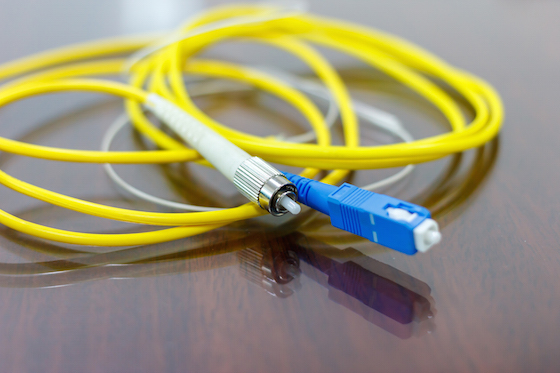If you want to get the speeds advertised by your internet provider — and enjoy great performance out of modern multimedia, conferencing, and other digital technologies — you need computer cabling suited to the task. Cabling comes in a wide variety from basic to space-age. Here’s an explanation of the computer cabling options available to help decide which is right for your networking.
Basic Coaxial vs. Twisted Pair
Coaxial cable delivers data to a building, while twisted pair computer cabling connects the devices on a network.
Coaxial cable (or coax) has a rugged outer shield that makes it reliable and protected underground and outdoors. The thick cable that runs from the wall and screws into your modem or networking system — that’s coax. The computer cabling that connects to a computer or other device by Ethernet port — that’s twisted pair.
Twisted pair computer cabling offers superior networking performance with faster speeds (with maximum speeds of 10x, 100x or even 1000x the speed of coax).
Options for twisted pair include different “Categories” with increasing speeds (see below). You can also choose between:
- Solid or Stranded. Solid runs long distances well. Stranded has multiple copper conductors and can more easily bend and twist.
- Shielded or Unshielded. Unshielded is most common and perfectly sufficient. Shielded has greater interference protection, if desired.
Category 5 & 5e
Cat 5 cabling became the standard for networking years ago but has been superseded by faster computer cabling. With speeds up to 100 Mbps at 100 Mhz bandwidth, most homes and some businesses can still enjoy more than adequate performance from Cat 5 computer cabling.
For faster speeds and less interference, you can upgrade to Cat 5e (“enhanced”). The interior design reduces crosstalk and allows speeds of up to 1 Gbps.
Category 6
A whole new generation of computer cabling — Category 6. Inside, special insulators carefully protect and separate the wires. For dynamic networking, Cat 6 offers a significant reduction in interference for better performance.
Interested in speed? Cat 6 takes things up a notch to 10 Gbps and 250 Mhz bandwidth. In fact, Cat 6 performs even better than most networks need. Right now, you can get the most out of your networking with Cat 6 computer cabling — and in the future, Cat 6 will suffice even as technologies improve.
Category 7
More expensive and largely unnecessary, Category 7 can power special applications that specifically need bandwidth up to 1000 Mhz. Cat 7 can theoretically provide speeds up to 40 Gbps and beyond, but such speeds are difficult to even acquire and currently only work at short distances. Check back in a decade or two to find out if Cat 7 has become more realistic.
Optical Fiber
Fiber computer cabling uses a glass or plastic core instead of copper wire to move data at nearly the speed of light. Optical fiber can handle 10 Gbps internet or even faster speeds. Notably, the fiber core can transmit speed at equal speeds in both directions.
For businesses that need real-time networking with high upload speeds — such as video conferencing or live financial transactions — fiber computer cabling holds plenty of appeal.
In general, Cat 5e or Cat 6 cabling can provide all the speed and performance you would expect from optical fiber. But if your property has or can receive optical fiber connectivity, it’s worth considering optical fiber computer cabling as another fast-paced, highly reliable option.
Networks only function as fast and reliably as the computer cabling that makes them run. Contact us today about installing cable to get the most out of your home or business network.


